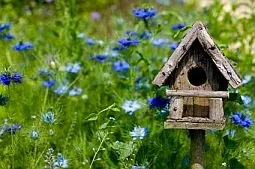Threatened woodland butterfly, The Pearl-Bordered Fritillary, one of the UK's rarest butterflies, has spread its wings again in the woodlands of East Sussex and Kent where it previously became extinct. A conservation project by the Forestry Commission, Butterfly Conservation and the RSPB is helping to secure the future of this woodland butterfly.
The Pearl-Bordered Fritillary butterfly, with white 'pearls' on the edge of its hindwing, has been seen in record numbers this year, following successful reintroductions by the Forestry Commission and the RSPB.
Like the three little pigs, a house martin’s mud hut is not all it’s cracked - up to be. But what some of the visiting birds raising their young in the UK this summer would love, are your empty ice cream or margarine tubs. The tubs make ideal homes for breeding house martins when theirs are damaged by the weather, says the RSPB.
House martins build nests on outer walls of buildings under the eaves out of pellets of mud mixed with grass and lined with feathers and vegetable fibre.
House martin nests have a tendency to fall with the young still inside, and the forecasted dry spell is likely to lead to this happening more frequently as the mud dries out and there is less grip.
The RSPB recommends an ice cream tubor large margarine tub as the perfect alternative, with a few easy steps creating the perfect temporary house martin home:
1.Take an empty four litre ice cream tub and cut an entrance in one of the longer sides, approximately 25 mm deep and 60-65 mm wide.
2. Make two small holes for fixing on the opposite side of the box.
3. Roughen the surface beneath the entrance hole to help the young birds scramble up to the opening.
4. Make two small drainage holes in the bottom of the tub and then put in the remains of the old nest (if you have it) or add hay to the tub.
5. Fix firmly in place as near to the original site as possible and then add the young birds and replace the lid.
The wildlife charity says that the cries of the young should encourage the parents back very quickly. If the tub is high under the eaves, the lid may be left off.
The breeding season runs from May to August when insects are abundant, but some chicks are still in the nest in September.
House martins are frequently double brooded and three broods are not uncommon so falling nests could occur over the next few weeks when the weather is forecasted to be extremely hot with more mini heatwaves.
Richard James, RSPB Wildlife Adviser says: “Callers to our helpline are often very distressed when they see that a house martin nest is on the floor and fear the worst.
“But it is possible to help these birds with temporary structures and a humble ice cream tub could actually help whole families be raised successfully!”
For more information on house martins visit www.rspb.org.uk
Image credit: Jonathan Osborne.









